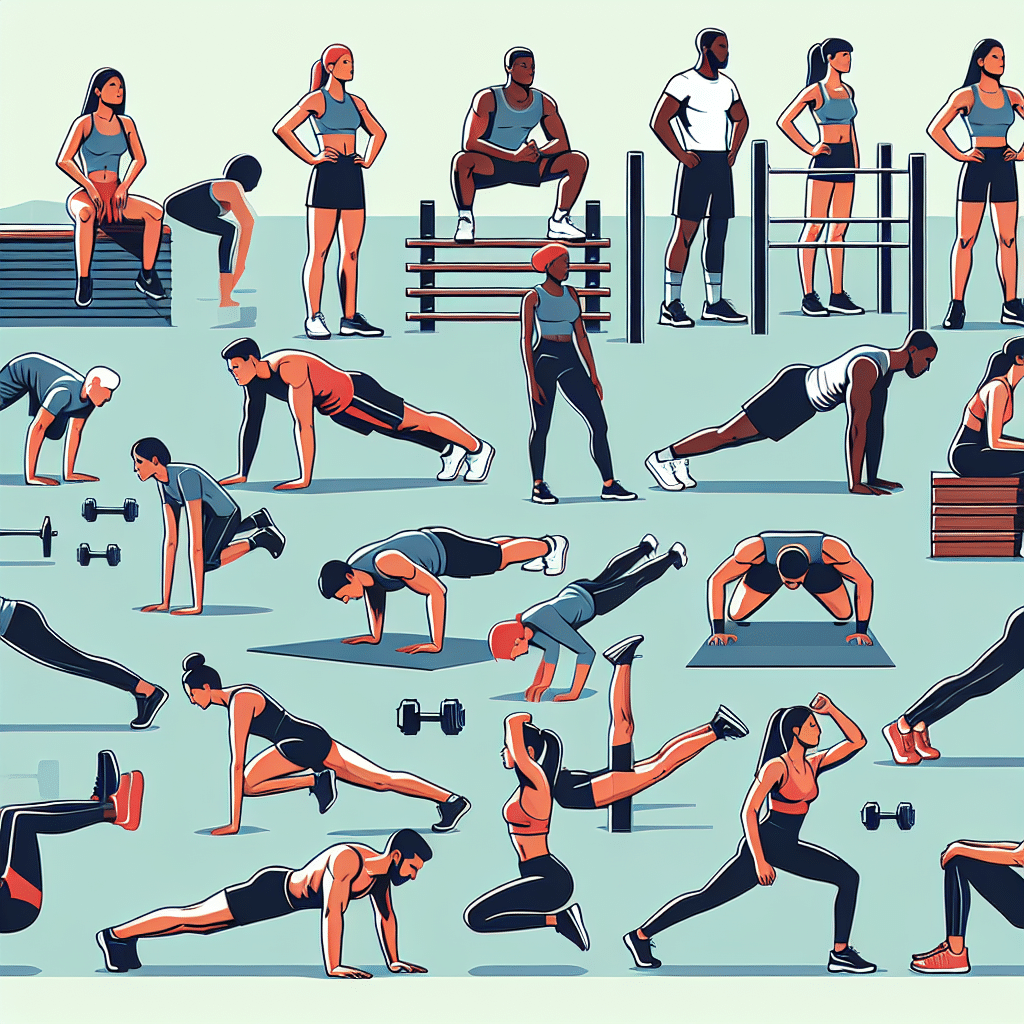Understanding Bodyweight Strength Training
Bodyweight strength training is a form of exercise where individuals use their body weight as resistance. This method can be highly effective for novices looking to improve strength, flexibility, and overall fitness. It requires no special equipment, making it accessible and easy to begin.
Benefits of Bodyweight Strength Training
- Accessibility: No gym membership or equipment required.
- Flexibility: Can be performed anywhere, from your living room to a park.
- Scalability: Workouts can be modified for all fitness levels.
- Strength Building: Effective for increasing muscle strength and endurance.
- Improved Core Stability: Engages multiple muscle groups, enhancing core strength.
- Injury Prevention: Proper body mechanics reduce the risk of injury.
Essential Bodyweight Exercises
1. Push-Ups
- Muscles Worked: Chest, shoulders, triceps, core.
- How to Perform: Start in a plank position, hands shoulder-width apart, lower your body until your chest nearly touches the ground, then push back up.
2. Squats
- Muscles Worked: Quadriceps, hamstrings, glutes.
- How to Perform: Stand with feet shoulder-width apart, bend at the knees and hips while keeping your chest upright, lower your body, and return to standing.
3. Lunges
- Muscles Worked: Quadriceps, hamstrings, glutes.
- How to Perform: Stand straight, step forward with one leg, lower your hips until both knees are bent at approximately 90 degrees, and return to standing.
4. Planks
- Muscles Worked: Core, shoulders, glutes, back.
- How to Perform: Lie face down, lift your body off the ground with forearms and toes, keeping your body in a straight line from head to heels.
5. Burpees
- Muscles Worked: Full body, including legs, arms, and core.
- How to Perform: From a standing position, squat down, kick your feet back into a plank, return to squat, and jump up with hands overhead.
6. Glute Bridges
- Muscles Worked: Glutes, hamstrings, core.
- How to Perform: Lie on your back, bend your knees, and push through your heels to lift your hips towards the ceiling.
Structuring Your Routine
Creating a balanced bodyweight strength training routine is vital for overall fitness. For novices, a three-day-a-week routine is ideal, allowing rest days in between to facilitate recovery and muscle growth.
Sample Weekly Schedule
-
Day 1: Upper Body Focus
- Push-Ups: 3 sets of 8-10 reps
- Planks: 3 sets of 30 seconds to 1 minute
- Burpees: 3 sets of 5-8 reps
-
Day 2: Lower Body Focus
- Squats: 3 sets of 10-15 reps
- Lunges: 3 sets of 8-10 reps per leg
- Glute Bridges: 3 sets of 12-15 reps
-
Day 3: Full-Body Focus
- Push-Ups: 3 sets of 6-10 reps
- Burpees: 3 sets of 5-8 reps
- Planks: 3 sets of 30 seconds
Proper Warm-Up and Cool Down
Warming up and cooling down are critical for a successful workout session. A 5-10 minute dynamic warm-up enhances blood flow and prepares your body for exercise, while a cool-down helps in recovery.
Warm-Up Routine
- Arm Circles: 1 minute
- Leg Swings: 1 minute per leg
- High Knees: 1 minute
- Torso Twists: 1 minute
Cool Down Routine
- Gentle Stretching: Focus on major muscle groups like quads, hamstrings, and shoulders.
- Deep Breathing: Help regulate heart rate and promote relaxation for 2-3 minutes.
Fitness Tips for Novices
- Listen to Your Body: If you feel pain (not to be confused with discomfort), stop the exercise.
- Focus on Form: Quality over quantity; proper techniques reduce injury risk.
- Stay Consistent: Work on your schedule diligently to build strength.
- Hydrate Well: Drink water before, during, and after workouts.
- Track Your Progress: Keep a log of your exercises, sets, and reps to monitor improvements and stay motivated.
Nutrition for Strength Training
Your diet plays a crucial role when engaging in bodyweight strength training. Consuming nutritious foods will enhance performance and recovery.
- Protein: Essential for muscle repair and growth. Include sources like chicken, fish, beans, and lentils.
- Carbohydrates: Fuels your workout and replenishes energy. Opt for whole grains, fruits, and vegetables.
- Fats: Necessary for energy and hormone production. Include healthy sources like avocados, nuts, and olive oil.
Conclusion
The journey into bodyweight strength training begins with understanding the fundamental exercises and structuring a routine that suits your lifestyle. By remaining consistent, focusing on form, practicing proper nutrition, and staying motivated, novices can effectively increase their strength and achieve their fitness goals.
